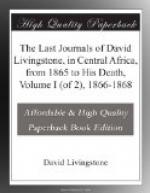We slept at a point of the Rovuma, above a cataract where a reach of comparatively still water, from 150 to 200 yards wide, allows a school of hippopotami to live: when the river becomes fordable in many places, as it is said to do in August and September, they must find it difficult to exist.
15th June, 1866.—Another three hours’ march brought us from the sleeping-place on the Rovuma to Metaba, the chief of which, Kinazombe, is an elderly man, with a cunning and severe cast of countenance, and a nose Assyrian in type; he has built a large reception house, in which a number of half-caste Arabs have taken up their abode. A great many of the people have guns, and it is astonishing to see the number of slave-taming sticks abandoned along the road as the poor wretches gave in, and professed to have lost all hope of escape. Many huts have been built by the Arabs to screen themselves from the rain as they travelled. At Kinazombe’s the second crop of maize is ready, so the hunger will not be very much felt.
16th June, 1866.—We heard very sombre accounts of the country in front:—four or five days to Mtarika, and then ten days through jungle to Mataka’s town: little food at Mtarika’s, but plenty with Mataka, who is near the Lake. The Rovuma trends southerly after we leave Ngozo, and Masusa on that river is pointed out as south-west from Metaba, so at Ngozo the river may be said to have its furthest northing. Masusa is reported to be five days, or at least fifty miles, from Metaba. The route now becomes south-west.
The cattle of Africa are like the Indian buffalo, only partially tamed; they never give their milk without the presence of the calf or its stuffed skin, the “fulchan.” The women adjacent to Mozambique partake a little of the wild animal’s nature, for, like most members of the inferior races of animals, they refuse all intercourse with their husbands when enceinte and they continue this for about three years afterwards, or until the child is weaned, which usually happens about the third year. I was told, on most respectable authority, that many fine young native men marry one wife and live happily with her till this period; nothing will then induce her to continue to cohabit with him, and, as the separation is to continue for three years, the man is almost compelled to take up with another wife: this was mentioned to me as one of the great evils of society. The same absurdity prevails on the West Coast, and there it is said that the men acquiesce from ideas of purity.




